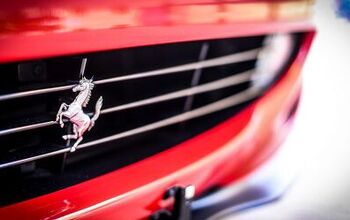Ferrari Fights The Future
Despite breaking new ground in the field of brand leverage with its Ferrari World Abu Dhabi theme park, Ferrari does seem to have lost the plot a bit in relation to its “other” business building expensive sportscars. Ferrari’s abandonment of the manual transmission might be justified by faster lap times at Fiorano, and the lightning-fast, dual-wet-clutch transmissions that replace them certainly seem to help keep the Scuderia at the bleeding edge of technology (even if they’re designed and built by Getrag). But underlying the faster times, higher speeds and “digital supercar” honorifics from the motoring press, there’s a sense that Ferrari’s progress must accommodate an ever-more ambitious business plan as much as design the world’s most capable and emotive sportscars. And it’s starting to bear some troubling fruit.
With “mainstream luxury” brands like BMW and Mercedes publicly committing to increased carbon fiber content in their street cars, and Ferrari’s new competitor Mclaren Automotive building its 458-fighting MP4-12C around a carbon fiber tub, you might think that they’re feeling the heat in Maranello. Or should we say, feeling the weight: thanks to its carbon tub, the MP4-12C’s dry weight is a feathery 2,866 compared to the 458’s 3,042 lb number. As we’ll explore further in a moment, Ferrari is incredibly sensitive to issues of perception, so wouldn’t you reckon that a high-carbon-fiber diet might be on the menu at the sign of the prancing horse? Speaking to Autocar, Ferrari’s CEO Amedeo Felisa says not so much:
The fact is that nobody today has a real understanding of what happens if you damage a carbonfibre structure. After 20 or 30 years of use, who knows what state a carbonfibre structure will be in? Only the airplane industry has a long-term understanding of using carbonfibre, and there the usage is very different. Unless you have a really big accident, it is possible to repair a Ferrari today, and we don’t want to lose that.
OK, since when did the ability to repair your Ferrari outweigh the mission to make the most advanced, performance-oriented cars in the world? This is, after all, one of the most notorious brands in the world in terms of ownership experience. As Robert Farago once famously put it, you don’t really own a Ferrari, you just visit it when it’s not in the shop. So, why give up 175 lbs to the upstart MP4-12C, which is gunning for the heart of Ferrari’s sales volume? Apparently to protect the even higher-profit limited-edition Ferraris.
We will only use carbonfibre on very special cars which have a very low rate of production and which are not for everyday use, such as the new Enzo
After all, who wants to see your $650k+ flagship hypercar bearing the hallowed name of Enzo be beat around Fiorano by a mere $280k+ hotted-up “volume model” like the F430 Scuderia? It’s happened before, and Ferrari seems determined not to let it happen again… even if that means holding the V8 models back relative to their competition. And this theme of flattering the most deep-pocketed drivers at the expense of an across-the-board commitment to pure performance doesn’t end there. With direct-injection engine technology proliferating across the industry, the shift towards smaller displacements and forced-aspiration is occurring in every segment. And with Felisa “hinting” that the next Enzo (due in 2012) could have a turbocharged V8, Ferrari might have an opportunity to introduce a high-performance, turbo-V6, possibly in the 458’s replacement. But, says Felisa:
There are no plans for a six-cylinder engine today. Ferrari will not build a six-cylinder engine until customer attitudes towards smaller engines change. The perception today is that the number of cylinders equates to the possibilities of the car. That is why we are developing hybrid technology that can be applied to our V8 and V10 cars. Hybrid means we can protect the V12.
Ironically, Felisa complains elsewhere at Autocar that Ferrari planned on offering its first hybrid
In 2015, if we are forced to by the [government] regulations. The issue of emissions for Ferrari is more a political one than real one. Lowering emissions of every Ferrari will not save the planet, but it will cost us a lot of money
Forced. Right. Because downsizing and focusing on weight isn’t enough. Don’t get me wrong, a biggish front-engined GT like the 599GTB should be offered with a V12 for as long as possible, and if hybrid technology helps Ferrari keep a 12-pot in its stable a little longer then good for them. After all, Ferrari can’t abandon its brand simply because some former F1 upstarts are targeting their business. But part of that brand is performance, and if the MP4-12C catches the 458 napping (say, on a Top Gear power lap, or Youtube video, Ferrari will have given the boys from Woking a toehold on which to rebuild their brand. But then maybe a little competition is exactly what Ferrari needs to stop prioritizing nouveau-riche cylinder-count envy, and starving its volume models of technology like carbon fiber simply to protect its hypercars. After all, Enzo didn’t get into the global branding and amusement park business.
More by Edward Niedermeyer
Latest Car Reviews
Read moreLatest Product Reviews
Read moreRecent Comments
- Varezhka Maybe the volume was not big enough to really matter anyways, but losing a “passenger car” for a mostly “light truck” line-up should help Subaru with their CAFE numbers too.
- Varezhka For this category my car of choice would be the CX-50. But between the two cars listed I’d select the RAV4 over CR-V. I’ve always preferred NA over small turbos and for hybrids THS’ longer history shows in its refinement.
- AZFelix I would suggest a variation on the 'fcuk, marry, kill' game using 'track, buy, lease' with three similar automotive selections.
- Formula m For the gas versions I like the Honda CRV. Haven’t driven the hybrids yet.
- SCE to AUX All that lift makes for an easy rollover of your $70k truck.

































Comments
Join the conversation
Millichili, anyone? Knowing Ferrari's pattern there is a more intense, more powerful, and even lighter 458 Scuderia/Challenge model already in the works. I think only their F1 team worries about McLaren.